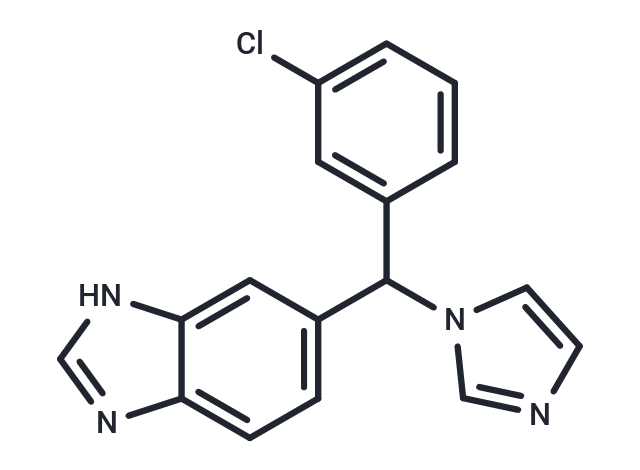Shopping Cart
Remove All Your shopping cart is currently empty
Your shopping cart is currently empty
Liarozole (R75251 dihydrochloride) is a cytochrome P450 (CYP450) dependent inhibitor, orally active, it also a potent inhibitor of estrogen (via inhibition of aromatase) and testicular androgen synthesis (inhibition of 17 ,20-lyase).Liarozole dihydrochloride is an imidazole derivative; it is being investigated as a non-hormonal agent in prostate cancer and in the treatment of various other cancers and skin disorders.

| Pack Size | Price | USA Warehouse | Global Warehouse | Quantity |
|---|---|---|---|---|
| 1 mg | $52 | In Stock | In Stock | |
| 5 mg | $123 | In Stock | In Stock | |
| 10 mg | $197 | In Stock | In Stock | |
| 25 mg | $388 | In Stock | In Stock | |
| 50 mg | $619 | In Stock | In Stock | |
| 100 mg | $987 | In Stock | In Stock | |
| 1 mL x 10 mM (in DMSO) | $135 | In Stock | In Stock |
| Description | Liarozole (R75251 dihydrochloride) is a cytochrome P450 (CYP450) dependent inhibitor, orally active, it also a potent inhibitor of estrogen (via inhibition of aromatase) and testicular androgen synthesis (inhibition of 17 ,20-lyase).Liarozole dihydrochloride is an imidazole derivative; it is being investigated as a non-hormonal agent in prostate cancer and in the treatment of various other cancers and skin disorders. |
| Targets&IC50 | CYP26:7 μM (IC50) |
| In vitro | Liarozole inhibits 17a-hydroxylase activity in bovine adrenal microsomes (IC50=0.15 μM) [1]. Liarozole has modest inhibitory activity on cholesterol synthesis in human hepatoma cells(IC50=5 μM)[1].Liarozole inhibits the metabolism of retinoic acid to more polar metabolites in hamster liver microsomes (IC50=2.2 μM), rat liver homogenate (IC50=0.14 μM), dunning prostate cancer homogenate (IC50=0.26 μM) and MCF-7 human breast cancer cells (almost complete block at 10μM) [1]. |
| Synonyms | R75251 dihydrochloride |
| Molecular Weight | 308.76 |
| Formula | C17H13ClN4 |
| Cas No. | 115575-11-6 |
| Smiles | Clc1cccc(c1)C(c1ccc2nc[nH]c2c1)n1ccnc1 |
| Relative Density. | 1.36g/cm3 |
| Storage | Powder: -20°C for 3 years | In solvent: -80°C for 1 year | Shipping with blue ice/Shipping at ambient temperature. | |||||||||||||||||||||||||||||||||||
| Solubility Information | DMSO: 55 mg/mL (178.13 mM), Sonication is recommended. | |||||||||||||||||||||||||||||||||||
| In Vivo Formulation | 10% DMSO+40% PEG300+5% Tween 80+45% Saline: 2 mg/mL (6.48 mM), Sonication is recommended. Please add the solvents sequentially, clarifying the solution as much as possible before adding the next one. Dissolve by heating and/or sonication if necessary. Working solution is recommended to be prepared and used immediately. The formulation provided above is for reference purposes only. In vivo formulations may vary and should be modified based on specific experimental conditions. | |||||||||||||||||||||||||||||||||||
Solution Preparation Table | ||||||||||||||||||||||||||||||||||||
DMSO
| ||||||||||||||||||||||||||||||||||||
| Size | Quantity | Unit Price | Amount | Operation |
|---|

Copyright © 2015-2025 TargetMol Chemicals Inc. All Rights Reserved.